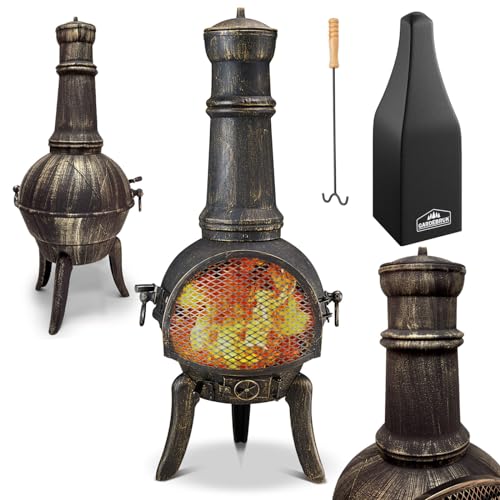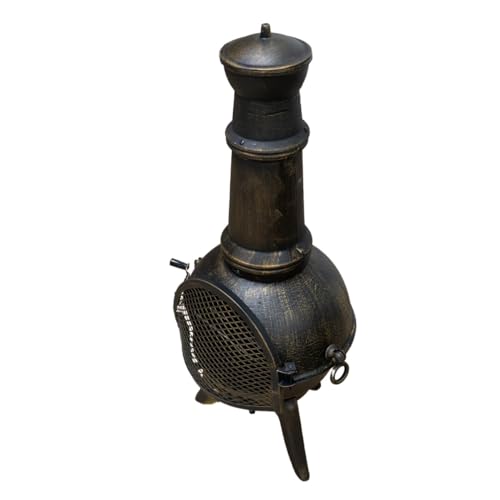10 Things Everyone Hates About Chimineas Clay
페이지 정보

본문
 Taking Care of a Clay Chiminea
Taking Care of a Clay Chiminea Chimineas made of clay can provide a decorative touch and practicality to any outdoor area. But, like any other fire pit or outdoor fireplace, a chiminea metal should be handled with care to preserve its beauty and utility.
Chimineas made of clay can provide a decorative touch and practicality to any outdoor area. But, like any other fire pit or outdoor fireplace, a chiminea metal should be handled with care to preserve its beauty and utility.Once they've been coated, clay chimneys are resistant to rain, snow, and sudden temperature changes. They can be a risk, and should be covered when not being used.
How are they made
Chimineas are a beautiful and functional method of keeping warm by the fire. They are typically made of clay but can also be made of metal or terra-cotta. They have a chimney to direct smoke into the air and a bulbous shape that allows for a huge fire to be set easily. They are able to hold warmth well and are ideal for keeping you warm outside all through the year. Chimineas made from clay are more fragile than metal counterparts, and could crack or break due to sudden temperature changes or physical damages. To prevent this from happening, they must be treated with care and get regular maintenance.
Mexican clay chimineas are a thriving business. Smaller factories still make use of kilns in a variety of sizes to create stunning outdoor fire pits. Kilns can be capable of holding 100 or more Chimineas and are heated up to temperatures over 1000c. This process takes about a week and the result is that the clay turns rock hard. Once this is done, it is ready to be used.
Make sure that your chiminea completely dry prior to use. This will prevent any water or moisture from absorbing into the clay, causing cracks to form. It is also recommended to purchase a cover to protect your chiminea from the snow or rain. It is also a good idea not to move your chiminea around too much. Once you have found your permanent home in the garden it is best not to move it again until you are absolutely required to do so as it will cause the clay to flex and possibly crack over time.
It is better to start your chiminea with smaller fires than larger ones. This will allow clay to get familiar with the heat in a gradual manner and prolong its life. This is known as "curing" or "seasoning" your chimenea. You should do this with all chimineas, regardless of whether they are made from clay, metal, or terracotta.
Function
A clay chiminea may be utilized as a source of heat, Tall Chiminea in addition to being an attractive garden ornament. It resembles an enormous potbelly, with a wide mouth on the front, and a tall chiminea - you could try this out - chimney on the top to let smoke escape.
A chiminea is not as big as a typical outdoor fireplace and won't heat the entire room, however it can provide an inviting space for people to sit around while the fire roars. They are often utilized in patios or gardens as a central spot for families and friends to cook, socialize, and unwind.
Chimineas can be found in different styles and sizes to match the style and design of any yard. They are typically made from natural materials such as clay, cast iron, or terracotta and may have metal parts that are coated to avoid the rusting. There are also some modern models made from aluminum and other metals that heat up faster and can be painted to match the home or landscape.
Clay and terracotta are less robust than chimineas made from metal and are susceptible to cracking or break if placed on a base that isn't solid and keeps them away from the ground. Clay and terracotta also get more hot than metal, so they should be kept away from areas where pets or children might be playing or walking.
The majority of chimineas have an empty base on which the fuel can be placed before lighting. Add a layer of sand or gravel to the base of the chiminea to protect it from the extreme heat created by the burning of wood. It is also recommended to construct the first fire in the chiminea with paper and small pieces firewood to prevent cracking of the clay.
The unique design of a chiminea allows the smoke to exit at the top through the chimney, thereby keeping the burning ash and flames away from anyone sitting close. This feature makes chimineas better than traditional firepits in conditions of wind, since the bowl is able to keep the smoke under control.
Maintenance
A chiminea is an excellent addition to any backyard. They are not only beautiful works of art and their flickering flames create a warm atmosphere perfect for entertaining family and friends or just sitting by the fire in the summer. Chimineas, as with any fire pit outdoors or fireplace, require some care to ensure safety and functionality.
It is crucial to keep your clay chiminea clean to prevent it from cracking. To begin, you'll need to remove any ash and other debris from the inside of the chiminea. To break up the dirt and ash clumps, you can use a wire-bristled broom or a scraper. You should then clean the exterior of the chimney with a paper towel or cloth and a mild cleaner like white vinegar distilled. This will eliminate all the soot and dust that has accumulated and stop the chiminea from becoming too oily.
Consider lining your chiminea with a sheet of paper to prevent it from catching fire. After you have removed the ashes from the chiminea, you must let it cure before attempting to use it again. It can take anywhere between four and eight small fires.
It is important to start heating your chiminea modern slowly prior to lighting an ignition. This will stop the clay from cracking when heated to high temperatures. Place a few inches of sand on the bottom of the container. light a fire using small pieces of kindling. After the fire is out, let the sand cool before building an even bigger fire. Continue the process, increasing the size of your fire every time until you've got an energizing fire.
It's better to repair your chiminea on your own if it cracks than to seek out a professional. Before you attempt to repair a chiminea that is cracked in clay, it's essential that the crack is not large enough to be considered a break. Also, you must make sure that the crack isn't surrounded by any paint, since this will peel off once it's heated up.
Safety
If you own a clay chiminea it needs to be handled with care. If handled improperly, they can be fragile and require to be sealed from time to the time. They should also be put on safe surfaces to prevent damage. They should not be positioned near eaves or patio roofs, or any other type covering that might catch fire. Set them in a place free of trees or shrubs that are overhanging. Before lighting a chimenea, is essential to verify weather forecasts. The clay can crack or break if exposed to extreme temperatures.
chimineas for sale can be found in different styles and shapes. The traditional one has the shape of a potbelly, with a narrow fireplace and a large opening in the front. The design permits it to burn with safety and even in rain, without water extinguishing the flames. They are a natural choice for outdoor parties and also for heating patios.
Metal chimineas can be more durable than clay models, but they are prone to rust and their surfaces get extremely hot. They are also not as safe to touch as clay or terra-cotta models.
There are a myriad of options for clay chimineas. Some are made from traditional clay, while others are more modern and can be used with any type of landscaping. They're available in sizes that can accommodate large or small wood-burning fires. Some models can be used to cook on.
When purchasing a clay chiminea, select its final home straight away as it's not something you'd want to move around a lot! When it's not in use, it is recommended that you purchase a cover. This will protect it from rain and repeated exposure to moisture, which could cause cracking or erosion of the clay over time.
Keep in mind that you should not add water to a fire in a clay chiminea, as this will cause it to crack. Only use sand or a dry material to extinguish the fire in the event that it goes out.
- 이전글Fire Pits & Chimineas Tips From The Top In The Business 25.02.16
- 다음글Why You Should Concentrate On Improving Buy An Old German Shepherd Dog 25.02.16
댓글목록
등록된 댓글이 없습니다.